The overwhelming majority of variants which The Koreans only carry have relation to brain and mental diseases

NCBI search results for gene with variants which The Korean only carry

SNV-1= SNVs (single nucleotide variant) detected in Korean individuals but not included in others (Europeans, The Chinese, The Japanese etc)
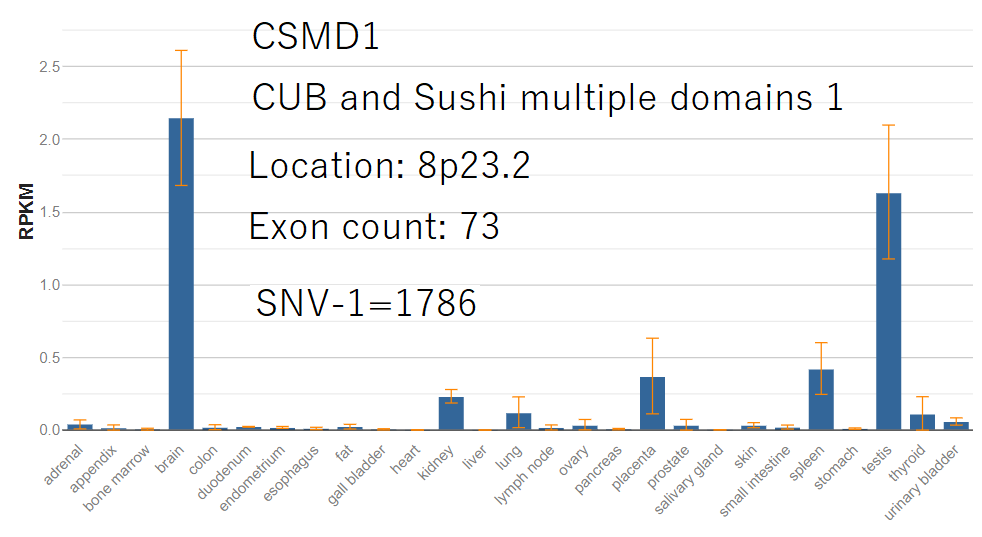
1.brain 2.testis
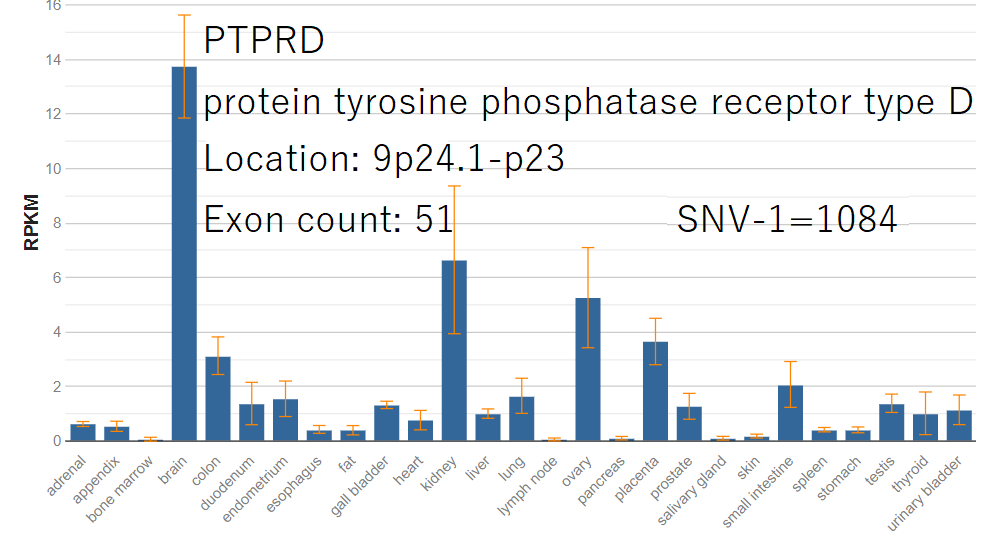
1.brain 2.kidney
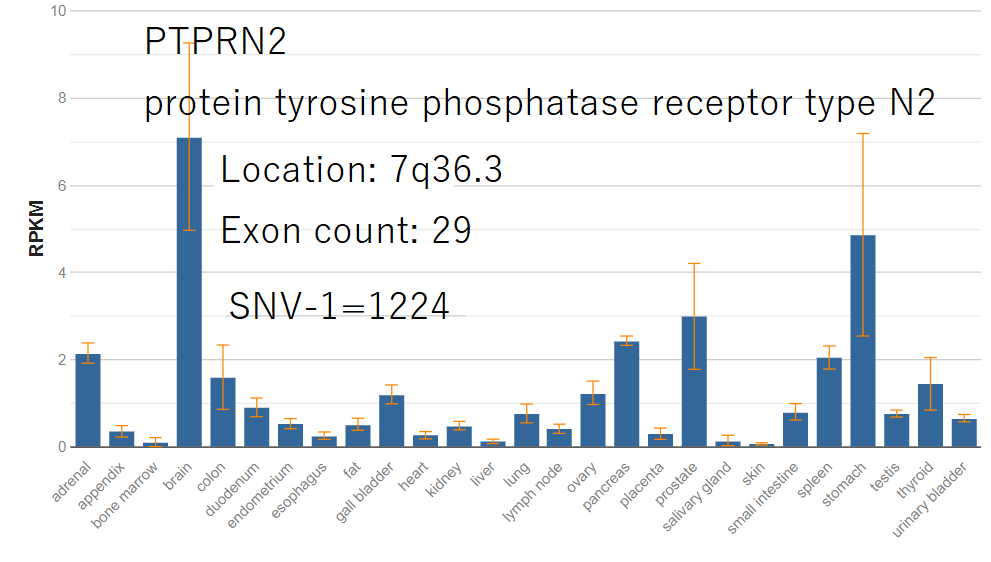
1.brain 2.stomatch
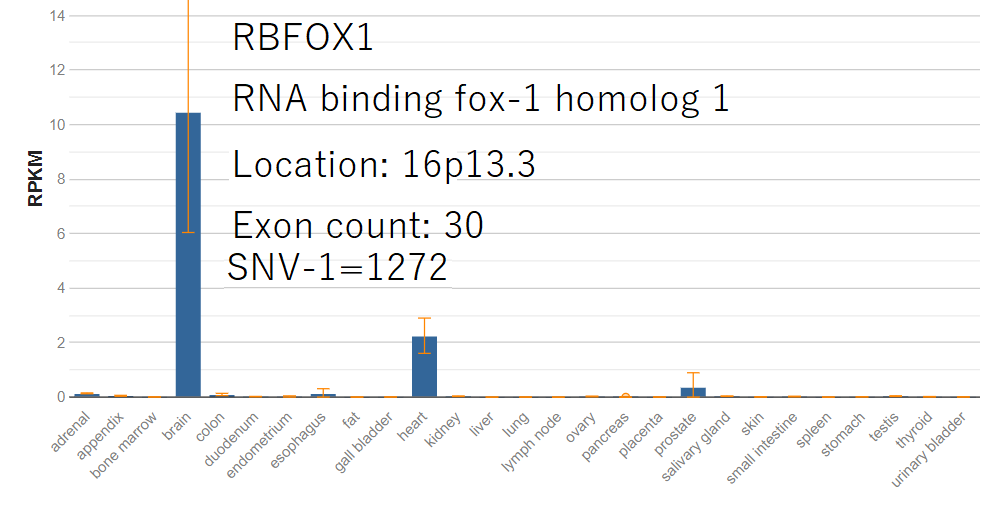
1.brain 2.heart
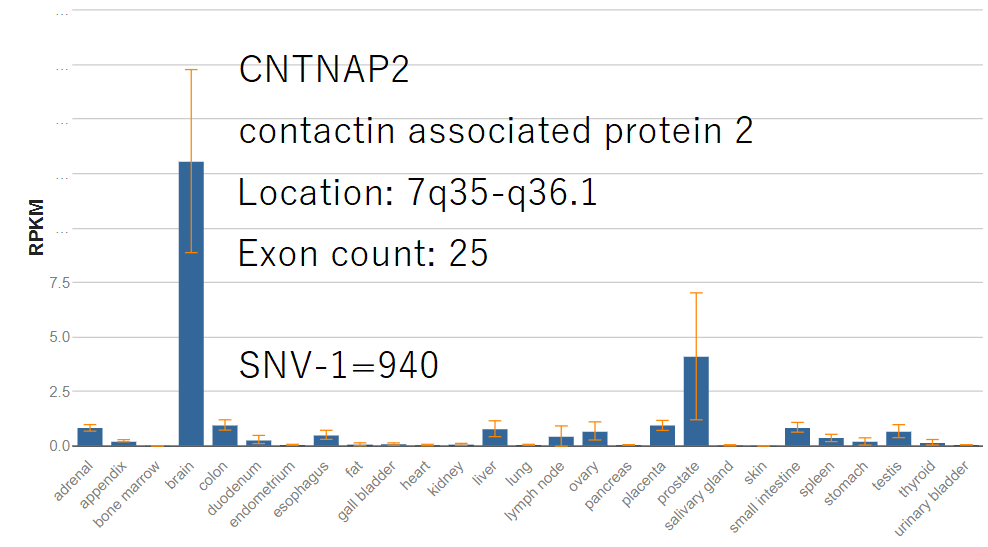
1.brain 2.prostate
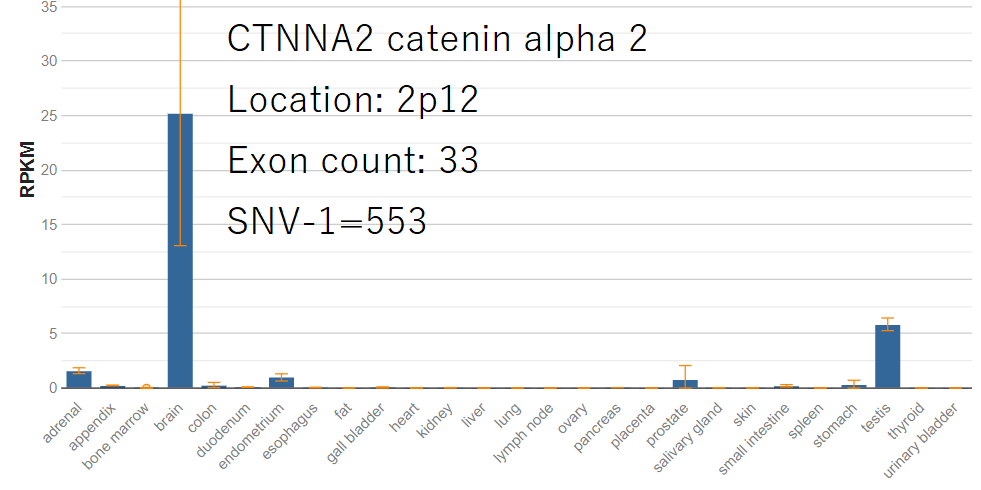
1.brain 2.testis
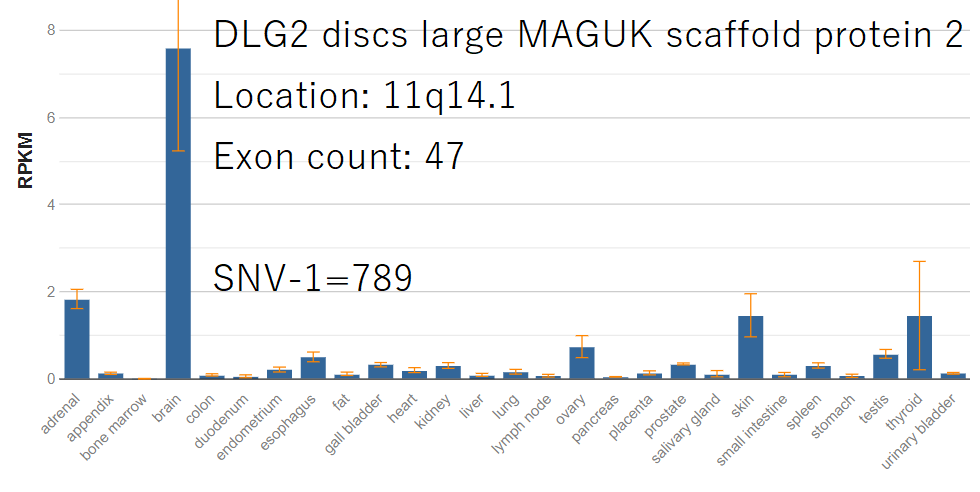
1.brain 2.adrenal
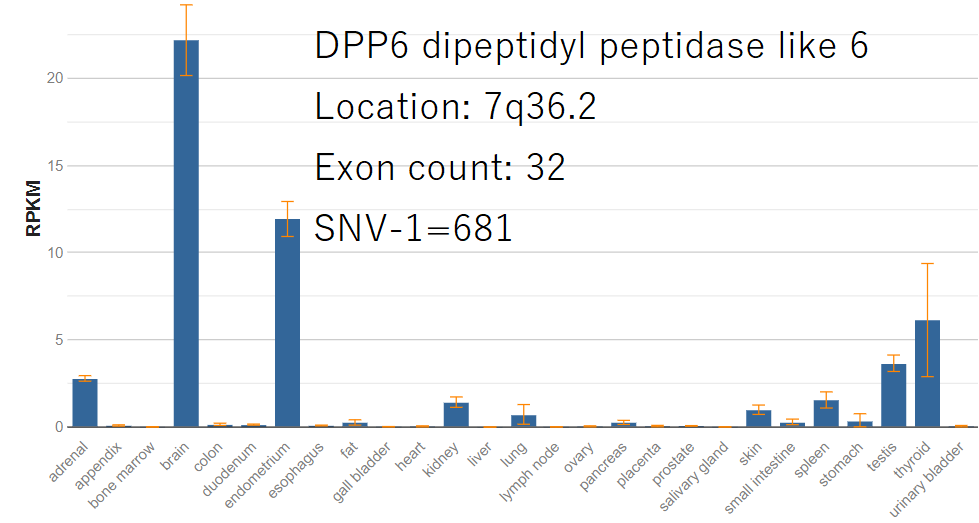
1.brain 2.endometrium
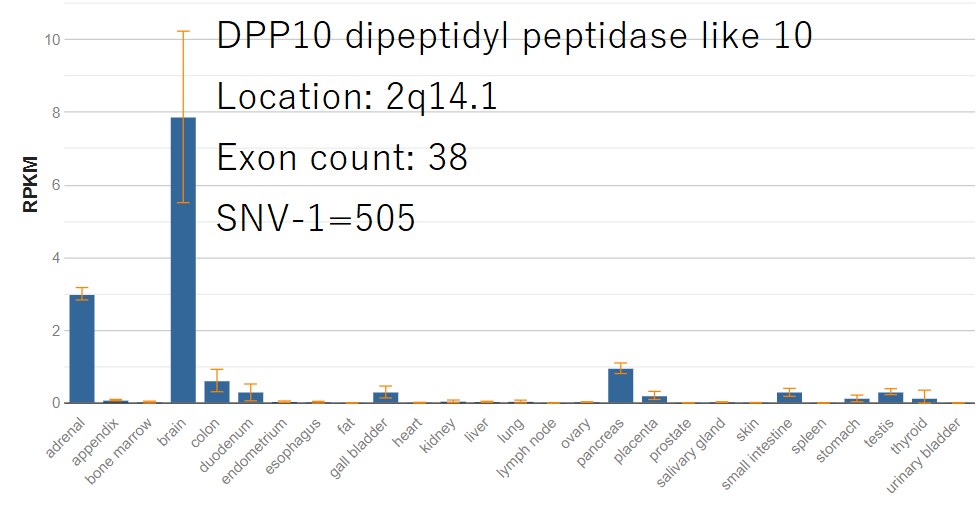
1.brain 2.adrenal
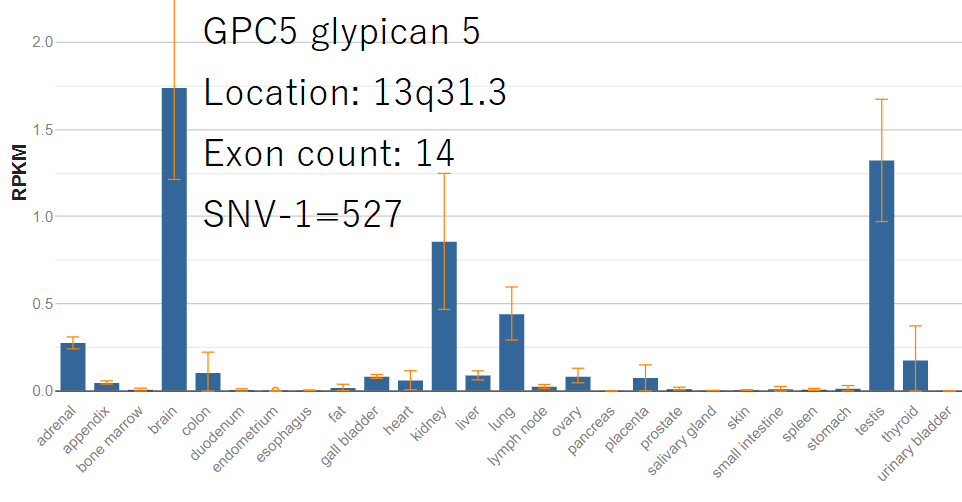
1.brain 2.testis
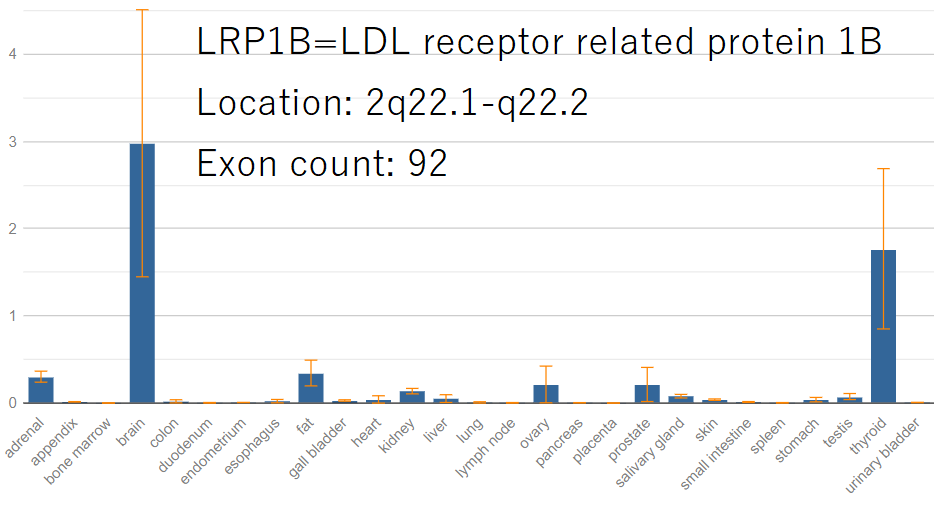
1.brain 2.thyroid
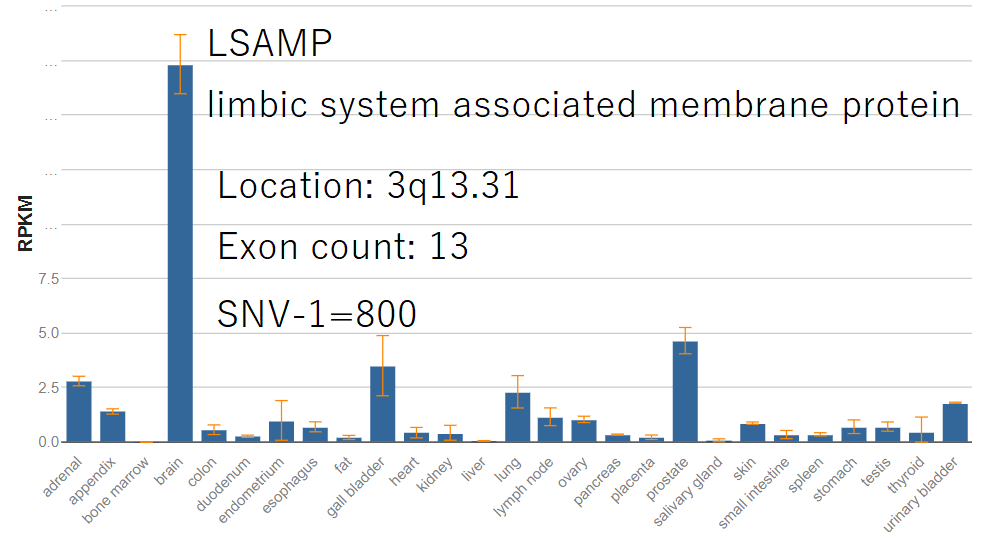
1.brain 2.prostate
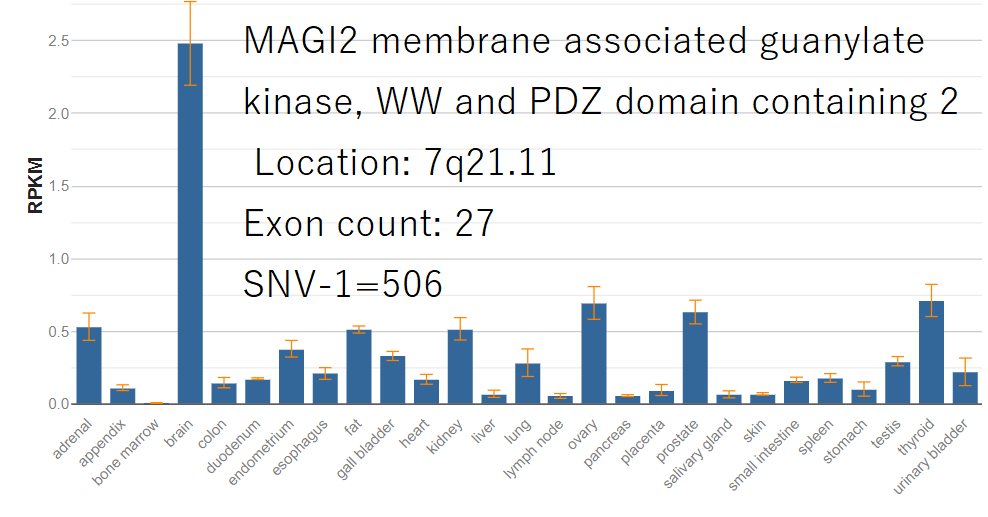
1.brain 2.others
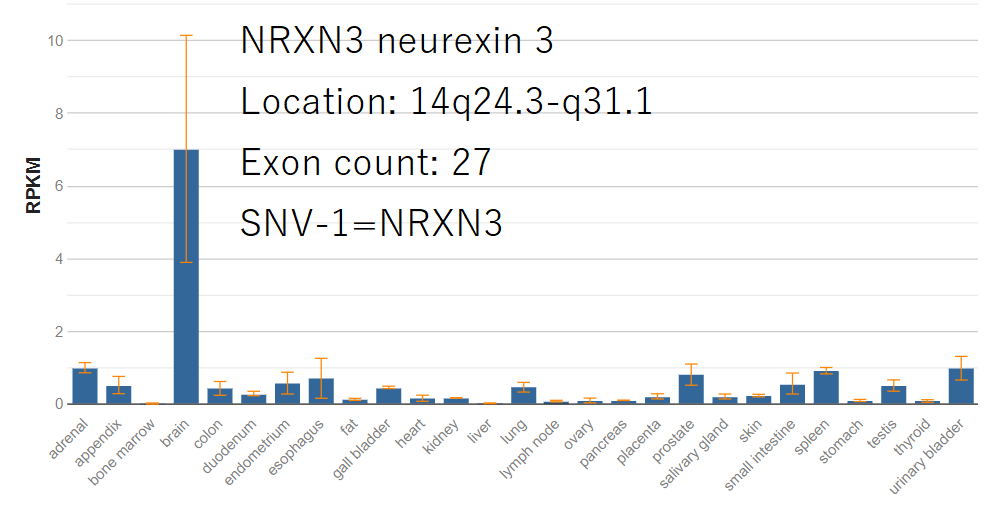
1.brain
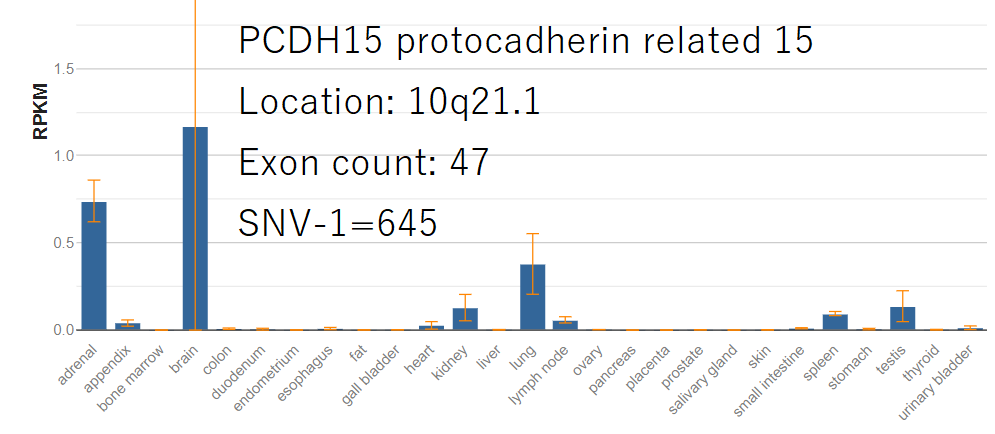
1.brain 2.adrenal
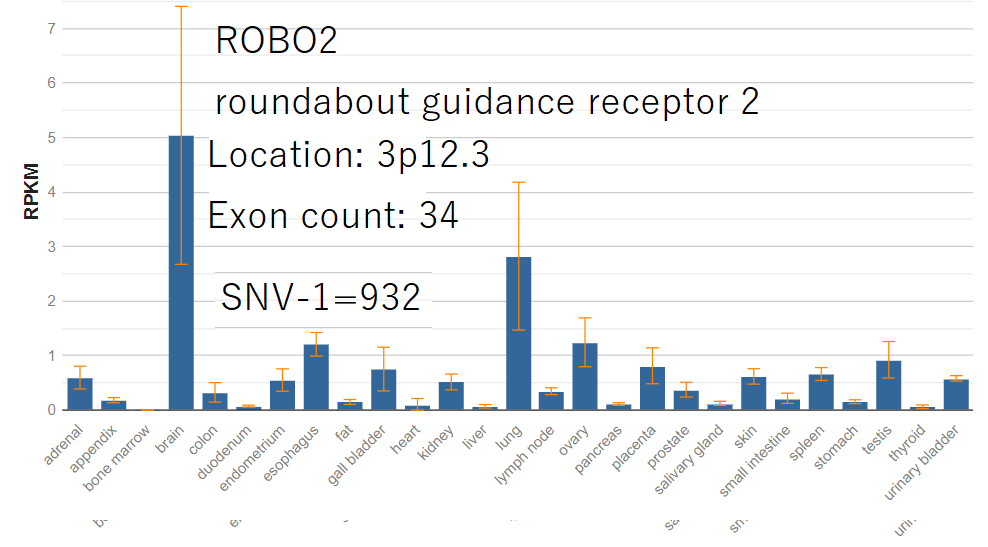
1.brain 2.lung
And so on ......
The above graphs which were shown in the NCBI search results indicates the body parts associated with gene which are variants(=mutation) that Koreans only carry, and the targeting gene symbol names used for the NCBI searching are a list of gene names with Korean-specific genetic mutations extracted from the following paper.It is very clear thing that the genes in which Korean-specific variants have occurred are related to the brain in the human body parts.
population genetics paper #1 (FDA)
Whole genome sequencing of 35 individuals provides insights into the genetic structure of Korean population
Wenqian Zhang et al.
Supplementary Table S5:
A list of genes involved in Korean SNV-1 and the SNV count per gene.
| SYMBOL Gene Name | # of SNVs |
| PRIM2 please see below |
5033 |
| Y_RNA Y chromosome |
3300 |
| CSMD1 please see above |
1786 |
| snoU13 No items found in NCBI |
1731 |
| PDE4DIP please see above |
1374 |
| RBFOX1 please see above |
1272 |
| PTPRN2 please see above |
1224 |
| KMT2C please see bellow |
1091 |
| PTPRD please see above |
1084 |
| LINC00842 please see below |
1008 |
| and so on | and so on |
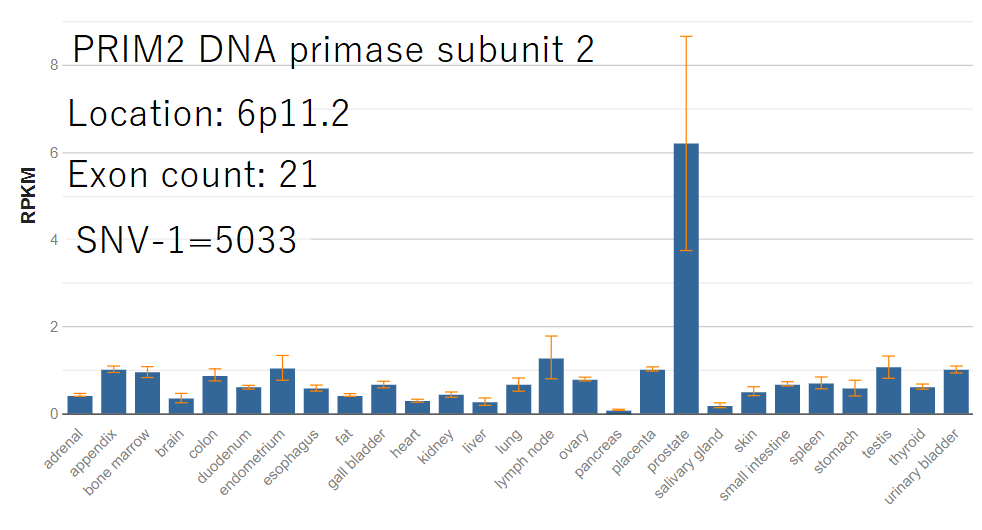
1.prostate
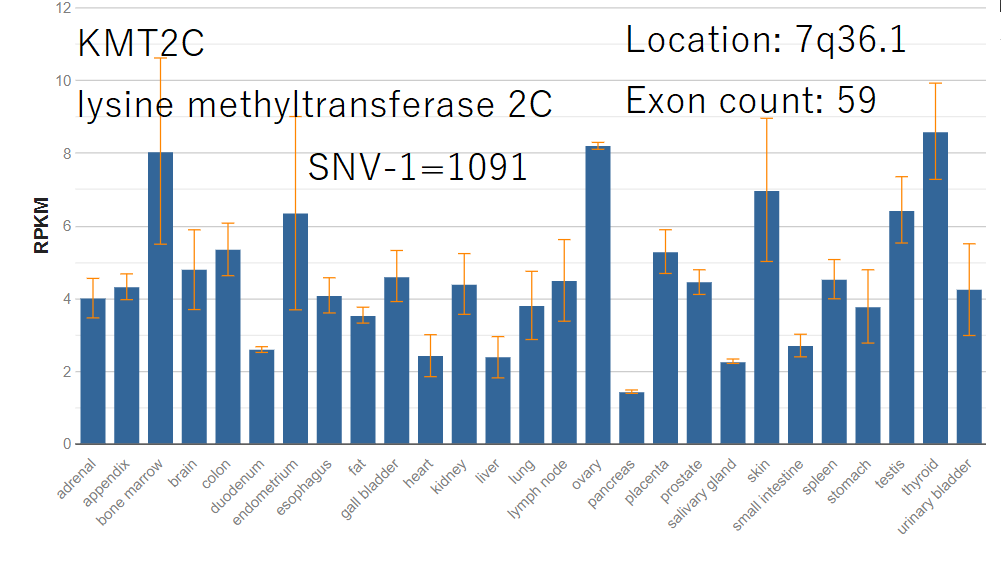
various
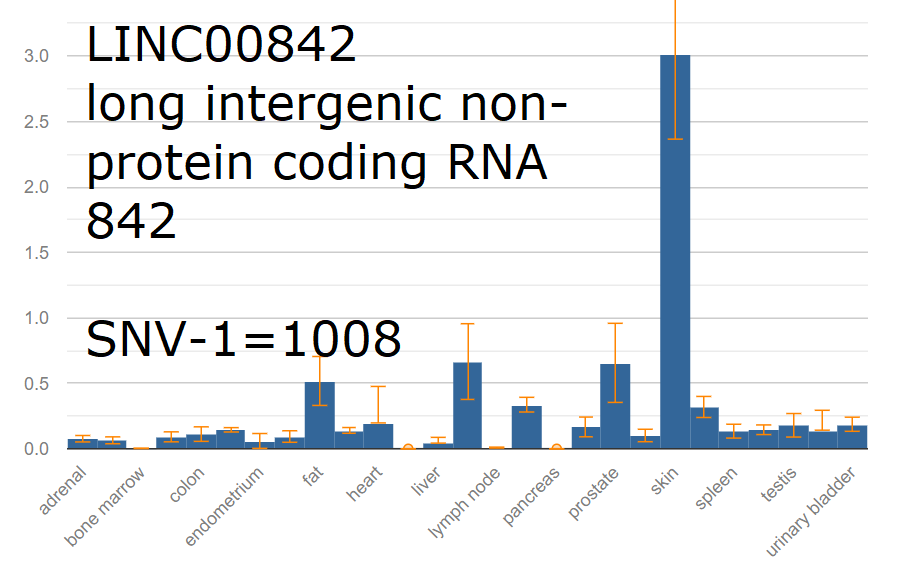
1.skin 2.liver
Answer by Google AI for gene with variants which The Korean only carry

The PRIM2 gene has been identified as a key player in the genetic basis of insomnia. Research has shown that PRIM2, along with other genes like RPA2, ORC6, and PIAS3, are core nodes in brain regions associated with insomnia. Studies have linked PRIM2 to the prenatal dorsolateral prefrontal cortex, inferolateral temporal cortex, medial prefrontal cortex, and amygdala, suggesting its role in regulating sleep-wake cycles and sleep disturbances. Additionally, research suggests a strong genetic component to insomnia, with studies indicating that genetics and epigenetics contribute to its development.
South Korea: Why so many struggle to sleep from BBC
South Korea is one of the most sleep deprived nations on earth. It also has the highest suicide rate among developed nations, the highest consumption of hard liquor and a huge number of people on antidepressants.
In Seoul, whole department stores are devoted to sleep products, from the perfect sheets to the optimum pillow, while pharmacies offer shelves full of herbal sleep remedies and tonics. And then there are the tech approaches to insomnia.
South Korea is one of the most sleep deprived nations on earth. It also has the highest suicide rate among developed nations, the highest consumption of hard liquor and a huge number of people on antidepressants.
In Seoul, whole department stores are devoted to sleep products, from the perfect sheets to the optimum pillow, while pharmacies offer shelves full of herbal sleep remedies and tonics. And then there are the tech approaches to insomnia.

Please note that the crucial point is that CSMD1 gene have relation to synaptic pruning.
1.The excessive synaptic pruning is the pathogenetic basis of schizophrenia.
2.The insufficient synaptic pruning is the pathogenetic basis of autism spectrum disorder (ASD).
3. The inadequate or irregular synaptic pruning is the basis of other psychiatric disorders.
And, we, humans around the world should know the very simple fact that The Koreans have a huge number of peculiar mutations in CSMD1 gene.

Small nucleolar RNAs (snoRNAs) are a class of non-coding RNAs that play a role in various diseases, including psychiatric disorders. Studies have shown that alterations in snoRNA expression are linked to conditions like autism spectrum disorder (ASD), schizophrenia, and major depressive disorder (MDD). snoRNAs can influence brain function and behavior by regulating gene expression and other cellular processes.
Here's a more detailed look:
1. SnoRNAs and Psychiatric Disorders:
Autism Spectrum Disorder (ASD):
Research suggests that dysregulated snoRNA expression in both blood and brain tissues is correlated with changes in synaptic gene functions in ASD.
Schizophrenia (SCZ):
While studies on snoRNAs in SCZ are still ongoing, some research indicates that snoRNAs may be involved in the disease's pathophysiology, potentially through sex-based dysregulation in the brain.
Major Depressive Disorder (MDD):
Several studies have identified snoRNAs associated with MDD, some using brain tissue and others using both brain tissue and blood samples.
Bipolar Disorder:
One study suggests that snoRNAs may be associated with bipolar disorder.
2. How SnoRNAs Influence the Brain:
Gene Regulation:
snoRNAs can influence alternative splicing and epigenomic and epitranscriptomic modifications, affecting cell proliferation, differentiation, and neurotransmission.
Synaptic Function:
Dysregulated snoRNA expression can impact synaptic gene functions, which are important for communication between neurons.
Neurotransmitter Regulation:
Some snoRNAs have been shown to affect neurotransmitter pathways, which are important for mood regulation and other mental processes.
Omitted below

The RBFOX1 gene has been linked to various mental disorders, including autism spectrum disorder (ASD), schizophrenia, and other neurodevelopmental conditions. RBFOX1 encodes a protein that regulates gene expression, and variations in this gene can disrupt normal brain development, contributing to the development of these disorders.
Mechanism of Action:
RBFOX1 acts as a splicing factor, meaning it regulates the process of how genes are expressed. Disruptions in this process can lead to abnormal brain function and contribute to the development of mental disorders.

The PDE4DIP gene, also known as Myomegalin (MMGL), has been linked to various mental health conditions, particularly in studies involving Alzheimer's disease (AD), vascular dementia (VaD), and frontotemporal dementia (FTD). Dysregulation of PDE4DIP expression is considered a potential early event that may contribute to the development of these dementias. Additionally, PDE4DIP has been implicated in schizophrenia and bipolar disorder.



And so on ......
My investigation results completely consistent with NCBI and Google AI.
Although there is no exact data, please don't misunderstand that the prevalence rates of schizophrenia are high among Koreans compared with other ethnic populations.
Notwithstanding that The Koreans-specific mutation undisputedly have relation to various mental disease and intellectual ability, the prevalence rate of various mental disease (e.g. schizophrenia) among Koreans may be same as other ethnic groups. To my knowledge, there is no paper published on Nature and other prestigious science-related journal in terms of "Hwabyeong" (or anger syndrome), this is probably because paper reviewers think that "Hwabyeong" is never "mental disease".
| gene | # of SNVs | Related papers |
|
PRIM2 |
5033 | insomnia paper[86] Schizophrenia paper[103] |
| CSMD1 | 1786 | Schizophrenia paper[9] paper[52] paper[115] paper[116] paper[141] paper[142] paper[148] paper[165] paper[178] paper[181] bipolar paper[66] paper[148] paper[165] paper[116] autism paper[137] cognitive ability paper[138] Amygdala in brain paper[139] rs10503253 Schizophrenia,Memory and learning ability paper[140] neurodevelopmental disorders (DSM-5) paper[179] |
|
snoU13 =snoRNAs U13 |
1731 | =gene symbol name means Small nucleolar RNAs (snoRNAs) U13 depression, insomnia paper[43] |
|
PDE4DIP |
1374 | mental disorders paper[4] paper[177] depression, paper[91] dementia paper[119] synapse paper[173] |
|
RBFOX1 |
1272 | intelligence paper[168] paper[169] insomnia paper[161] autism paper[165] anger,aggression,autism paper[100] Schizophrenia paper[5] paper[167] depression, Schizophrenia, neurosis paper[121] Personality, alcoholism, paper[122] ADHD paper[123] paper[182] aggressive behavior paper[124] Schizophrenia (the neuronspecific RNA splicing regulator) paper[125] Many other related papers |
|
PTPRN2 |
1224 | Personality disorders paper[99] depression paper[6] Schizophrenia, ADHD paper[126] |
|
KMT2C |
1091 | intelligence paper[159] bipolar paper[7] paper[130] Schizophrenia paper[128] depression paper[129] |
|
PTPRD |
1084 | insomnia paper[161] intelligence paper[159] paper[168] ADHD paper[165] bipolar paper[165] Personality disorders paper[8] paper[165] paper[127] Schizophrenia, synaptic adhesion paper[125] intellectual disability, anxiety, Personality disorders paper[127] autism paper[137] Personality disorders paper[143] Neuroticism paper[143] |
|
LINC00842 |
1008 |
0 |
|
CNTNAP2 |
940 | intellectual disability, autism paper[109] Schizophrenia paper[10] paper[165] mental disorders,language development disorder paper[131] paper[175] Personality disorders paper[176] |
|
ROBO2 |
932 | >Schizophrenia, depression paper [13] autism paper [117] |
| ZNF717 | 859 | intellectual disability paper[14] psychoneurosis paper[93] brain paper[94] autism paper[132] |
|
CROCC |
844 | 0 |
| AF146191 | 800 | insomnia paper[101] |
| LSAMP | 800 | insomnia paper[161] suicide paper[15] bipolar paper[165] |
|
WWOX |
797 | mentally retardation
paper[81] autism paper[165] |
|
DLG2 |
789 | Schizophrenia
paper[5] |
|
GUSBP1 |
760 | 0 |
|
EYS |
759 | Schizophrenia paper[5] bipolar paper[160] |
|
ANKRD30BL |
730 | 0 |
|
PCDHA1 ~ PCDHA14 |
710 | Schizophrenia paper[166] |
|
MACROD2 |
693 | intelligence paper[168] paper[169] autism paper[165] bipolar paper[5] depression paper[158] |
|
DPP6 |
681 | neurodevelopmental disorders paper[89] |
|
LRP1B |
677 | intelligence paper[159] cognitive ability paper[5] Schizophrenia paper[165] |
|
TPTE |
664 | intelligence paper[159] depression paper[110] |
|
ANKRD36C |
653 | 0 paper[112] Alzheimer’s Disease |
|
PCDH15 |
645 | cognitive ability paper[114] Schizophrenia・autism paper[82] ADHD paper[182] |
|
FHIT |
642 | Schizophrenia paper[5] paper[165] |
| LINC00969 | 640 | Schizophrenia
paper[57] |
|
KCNJ12 |
626 | depression paper[113] |
|
BAGE2 |
618 | 0 paper[146] Alzheimer’s Disease |
|
UPK3B |
608 | 0 |
| CTNNA3 | 605 | Schizophrenia paper[165] autism paper[79] impulsive behavior paper[172] effectiveness of antidepressants paper[98] |
|
NRXN3 |
602 | neuropsychiatric disease paper[80] autism paper[117] |
| CDH13 | 600 | autism, Schizophrenia, bipolar, depression, ADHD paper[16] paper[64] Schizophrenia, ADHD paper[165] Personality disorders paper[176] |
|
SGCZ |
582 | intelligence paper[168] depression paper[73] |
|
CNTN5 |
568 | suicide paper[74] |
| PARK2 | 568 | intelligence paper[159] intellectual disability, autism paper[109] Personality disorders paper[75] |
| MAP2K3 | 564 | General mental deseases paper[76] autism paper[146] |
| CCSER1 | 564 | 0 alcoholism paper[77] |
|
GRID2 |
561 | 0 stress paper[78] |
|
CTNNA2 |
553 | intelligence paper[168] educational attainment paper[5] impulsive behavior paper[172] |
| DAB1 | 528 | insomnia paper[161] mentally retardation paper[44] Schizophrenia paper[165] |
|
GPC5 |
527 | intelligence paper[159] cognitive ability paper[45] |
| NAALADL2 | 519 | autism paper[46] |
|
MAGI2 |
50MAGI26 |
Schizophrenia, depression [paper[47] Personality [paper[75] Schizophrenia, synaptic adhesion paper[125] paper[165] |
|
DPP10 |
505 | Neurodevelopmental disorders paper[177] ADHD paper[48] |
|
PDE4D |
503 | intelligence paper[168] paper[169] personal disorder paper[49] synapse paper[173] |
|
KCNIP4 |
497 | Personality disorders, ADHD paper[50] |
| CNTN4 | 485 | intellectual disability, autism paper[109] paper[177] Schizophrenia paper[40] paper[165] autism paper[137] bipolar paper[160] |
|
TBC1D5 |
478 | paper[51] bipolar |
|
AGBL4 |
474 | paper[52] cognitive ability |
|
ASIC2 |
471 | paper[52] Schizophrenia |
|
CADM2 |
471 | intelligence paper[118] paper[168] General mental deseases paper[38] cognitive ability paper[88] |
|
CDH12 |
469 | Schizophrenia, bipolar, depression paper[24] |
| ZDHHC11 | 468 | intelligence paper[159] |
|
ADARB2 |
468 | autism paper[53] |
|
DCC |
467 | intelligence paper[135] paper[168] paper[169] insomnia paper[161] cognitive ability paper[5] ADHD, depression paper[134] paper[162] autism paper[162] depression paper[136] paper[137] paper[174] Schizophrenia paper[162] impulsive behavior paper[171] paper[172] brain capacity paper[164] |
|
GALNTL6 |
459 | intelligence paper[159] |
|
ANKRD36 |
458 | 0 alcoholism paper[54] |
|
CDH4 |
457 | intelligence paper[168] Schizophrenia paper[25] |
| PRR4 | 457 | Schizophrenia paper[55] |
|
LRRC4C |
448 | intelligence paper[159] anorexia paper[5] Schizophrenia, synaptic adhesion paper[125] |
|
MIR44351HG |
445 | 0 |
|
LINC00960 |
443 | Schizophrenia paper[56] |
|
SLC9B1P4 |
442 | 0 |
|
PTPRT |
434 | intelligence paper[168] paper[169] intellectual disability paper[58] autism paper[165] |
| SDK1 | 431 | insomnia paper[161] child abuse paper[59] Personality disorders paper[176] |
| PARD3B | 430 | intelligence paper[159] Personality disorders paper[60] |
|
SLC9B1P1 |
425 | 0 |
|
TAS2R14 |
421 | 0 |
|
RUNX1 |
420 |
mentally retardation paper[61] |
|
AUTS2 |
420 | intelligence paper[168] paper[169] intellectual disability, autism paper[111] Schizophrenia,autism paper [42],[53] |
|
CSMD3 |
418 | autism paper[62] neurodevelopmental disorders (DSM-5) paper[180] |
|
NRXN1 |
418 | intelligence paper[159] intellectual disability, autism paper[109] autism, Schizophrenia paper[35] paper[95] autism paper[117] Schizophrenia, synaptic adhesion paper[125] mental disorders,Schizophrenia,autism paper[131] paper[167] |
|
LINC00955 |
418 | 0 |
|
ZNF385D |
418 | Schizophrenia paper[63] |
|
PRKG1 |
417 | ADHD paper[64] impulsive behavior paper[172] |
|
CAMTA1 |
416 | intelligence paper[159] paper[169] memory ability paper[65] |
|
SPAG16 |
414 | bipolar paper[66] paper[156] |
|
TMEM132D |
410 | intelligence paper[159] personarity disorder paper[67] anxiety paper[165] |
|
ROBO1 |
409 | math ability paper[68] |
|
GPC6 |
408 | autism paper[69] paper[137] |
|
NBPF1 |
407 | brain capacity paper[92] |
|
LRRTM4 |
406 | tourette syndrome paper[70] |
| 405 | brain capacity ppaper[71] brain paper[105] |
|
|
NCOR1P2 |
402 | 0 |
|
TTC34 |
400 | 0 |
|
NKAIN2 |
398 | intelligence paper[72] Schizophrenia paper[72] |
|
SMYD3 |
397 | mentally retardation
paper[41] |
|
RPTOR |
395 | intelligence paper[159] Schizophrenia paper[40] |
|
AC090044.1 |
394 | 0 |
|
OPCML |
390 | Schizophrenia paper[37] paper[165] |
| SNX29 | 390 | intelligence paper[168] paper[169] insomnia paper[161] educational attainment paper[5] autism paper[26] |
|
NRG1 |
388 | ADHD paper[2] bipolar paper[104] Schizophrenia paper[11]paper[87] Schizophrenia, synaptic plasticity related genes paper[125] |
|
ERBB4 |
387 | intelligence paper[159] Schizophrenia paper[36] autism paper[117] |
|
ERC2 |
386 | autism,Schizophrenia paper[35] Schizophrenia, ADHD paper[126] |
|
NTM |
385 | insomnia paper[161] intelligence paper[34] |
|
SRGAP2B |
383 | Brain development paper[83] |
|
SLC9B1P3 |
383 | 0 |
|
CNTNAP3B |
379 | cognitive ability paper[39] Appendix 4 |
|
GRM7 |
379 | bipolar paper[33] |
|
CACNA2D3 |
379 | Schizophrenia paper[32] paper[125] Personality disorders paper[176] |
|
MIR663A |
376 | 0 |
|
SNTG1 |
376 | cerebral cortex paper[163] |
|
SUMF1 |
374 | mentally retardation paper[31] |
|
SORCS2 |
373 | bipolar, paper[30] paper[165] |
|
DMD |
373 | autism paper[117] |
|
HYDIN |
372 | brain capacity paper[85] |
|
DGKB |
372 | cognitive ability paper[29] |
|
NRG3 |
371 | Schizophrenia paper[28] Schizophrenia,synaptic plasticity related genes paper[125] |
|
FAM182B |
369 | 0 |
|
TEKT4P2 |
368 | 0 |
|
DIP2C |
367 | General mental deseases paper[27] |
|
AGBL1 |
366 | autism paper[26] |
|
CDH18 |
364 | Schizophrenia,bipolar,depression paper[24] |
|
HERC2P3 |
364 | ADHD paper[23] |
|
FRG2C |
363 | ADHD paper[23] |
|
TRPM3 |
359 | intellectual disability paper[22] |
|
TRAPPC9 |
358 | mentally retardation
paper[21] intellectual disability paper[133] |
|
ERICH1AS1 |
357 | Schizophrenia paper[5] |
|
DLGAP1 |
355 | Schizophrenia paper[20] |
|
HDAC9 |
354 | Schizophrenia paper[19] |
|
CTNND2 |
354 | intelligence paper[159] intellectual disability paper[18] |
| C10orf11 | 351 | cerebral cortex paper[163] |
|
ASTN2 |
348 | brain capacity paper[164] Schizophrenia, bipolar, autism paper[165] |
|
CNTNAP5 |
340 | bipolar paper[160] |
|
PCDH9 |
330 | intellectual disability, autism paper[109] |
|
SHANK2 |
322 | intellectual disability, autism paper[109] paper[109] paper[151] paper[152] paper[153] paper[154] depression paper[129] paper[157] autism, ADHD paper[149] neuropsychiatric disorders paper[150] ADHD paper[155] |
| FIP1L1 | 320 | cerebral cortex paper[163] |
|
EXOC4 |
320 | intelligence paper[147] paper[135] paper[168] paper[169] |
|
DPYD |
319 | Personality disorders paper[97] autism paper[117] intelligence paper[159] paper[168] |
| LARGE | 317 | intelligence paper[159] paper[168] |
|
NEGR1 |
312 | insomnia paper[161] intelligence paper[135] paper[147] paper[168] paper[169] depression paper[158] |
|
CALN1 |
311 | intelligence paper[159] paper[168] paper[169] |
|
NPAS3 |
309 | insomnia paper[161] intelligence paper[159] Schizophrenia paper[165] |
| THSD7B | 306 | intelligence paper[159] Personality disorders paper[176] |
|
AGAP1 |
303 | intelligence paper[159] paper[168] paper[169] |
| CACNA1C | 302 | autism paper[177] Schizophrenia paper[95] paper[141] paper[148] paper[166] paper[166] paper[181] |
And so on ......
List of paper names
paper[1]
Rare coding variants in 10 genes confer substantial risk for schizophrenia.
Singh TJ et al.
Nature. April 6, 2022
paper[2]
an intriguing therapeutic target for neurodevelopmental disorders
Liang Shi & Clare M. Bergson
Nature Published: 16 June 2020
paper[3]
An interaction network of mental disorder proteins in neural stem cells
M J Moen et al,
Nature Published: 04 April 2017
paper[4]
Association between SNPs and gene expression in multiple regions of the human brain
S Kim et al,
Nature Published: 08 May 2012
paper[5]
Identification of pleiotropy at the gene level between psychiatric disorders and related traits
Tatiana Polushina et al,
Nature Published: 29 July 2021
[cited from the above paper]
Here, we aimed to identify genetic overlaps at the gene level between 7 mental disorders (schizophrenia, autism spectrum disorder, major depressive disorder, anorexia nervosa, ADHD, bipolar disorder and anxiety), 8 brain morphometric traits, 2 cognitive traits (educational attainment and general cognitive function) and 9 personality traits (subjective wellbeing, depressive symptoms, neuroticism, extraversion, openness to experience, agreeableness and conscientiousness, children’s aggressive behaviour, loneliness) based on publicly available GWASs.
paper[6]
A Genomewide Linkage Scan of Cocaine Dependence and Major Depressive Episode in Two Populations
BaoZhu Yang et ai.
Nature Published: 17 August 2011
paper[7]
Exome sequencing for bipolar disorder points to roles of de novo lossoffunction and proteinaltering mutations
M Kataoka et al.
Nature Published: 24 May 2016
paper[8]
Genomewide association study in obsessivecompulsive disorder: results from the OCGAS
M Mattheisen
Nature Published: 13 May 2014
paper[9]
The SchizophreniaAssociated Gene, CSMD1,Encodes a BrainSpecific Complement Inhibitor
Matthew L Baum
Harvard Libraly
paper[10]
CNTNAP2 gene dosage variation is associated with schizophrenia and epilepsy
J I Friedman et al.
Nature Published: 24 July 2007
paper[11]
The molecular genetics of schizophrenia: new findings promise new insights M J Owen et al.
Nature Published: 28 October 2003
paper[12]
A genomewide investigation into parentoforigin effects in autism spectrum disorder identifies previously associated genes including SHANK3
Siobhan Connolly et al.
Nature Published: 23 November 2016
paper[13]
Convergence of evidence from a methylomewide CpGSNP association study and GWAS of major depressive disorder
Karolina A. Aberg et al.
Nature Published: 22 August 2018
[cited from the above paper]
ROBO2 (roundabout, axon guidance receptor, homolog 2) is critical for the maintenance of inhibitory synapses in the adult ventral tegmental area, a brain region important for the production of dopamine[41], and has been implicated in schizophrenia[42],[43],[44] and bipolar depression[45].
paper[14]
Identification of 11 potentially relevant gene mutations involved in growth retardation, intellectual disability, joint contracture, and hepatopathy
Hongyan Diao et al.
Published online 2018 Nov 16
paper[15]
Association of limbic systemassociated membrane protein (LSAMP) to male completed suicide
Anne Must et al.
Published: 23 April 2008
[cited from above paper]
According to the results of the current study, there might be a chance that variations in LSAMP gene play a role in pathoaetiology of suicidal behaviour.
paper[16]
The role of cadherin genes in five major psychiatric disorders: A literature update
Ziarih Hawi et al.
published: 18 September 2017
paper[17] Chromosome aberrations involving 10q22: report of three overlapping interstitial deletions and a balanced translocation disrupting C10orf11
Andreas Tzschach et al.
Nature Published: 21 October 2009
paper[18]
CTNND2— a candidate gene for reading problems and mild intellectual disability
Wolfgang Hofmeister et al.
February 3, 2015
paper[19]
HDAC9 is implicated in schizophrenia and expressed specifically in postmitotic neurons but not in adult neural stem cells
Bing Lang et al.
Published online 2011 Aug 18.
paper[20]
Genetic analysis of the DLGAP1 gene as a candidate gene for schizophrenia
JunMing Liet al
30 January 2013
paper[21]
Identification of Mutations in TRAPPC9, which Encodes the NIK and IKKβBinding Protein, in Nonsyndromic AutosomalRecessive Mental Retardation
Asif Mir et al.
11 December 2009
paper[22]
Diseaseassociated mutations in the human TRPM3 render the channel overactive via two distinct mechanisms
Siyuan Zhao et al.
eLife 2020
paper[23]
De novo and inherited CNVs in MZ twin pairs selected for discordance and concordance on Attention Problems
Erik A Ehli et al.
Nature Published: 11 April 2012
paper[24]
A novel relationship for schizophrenia, bipolar and major depressive disorder Part 5: a hint from chromosome 5 high density association screen
Xing Chen et al.
Published online 2017 May 15.
paper[25]
Neuronal cell adhesion genes Key players in risk for schizophrenia, bipolar disorder and other neurodevelopmental brain disorders?
Aiden P. Corvin
01 Oct 2010
paper[26]
Genomewide association analysis of autism identified multiple loci that have been reported as strong signals for neuropsychiatric disorders
Lu Xia et al.
published: 24 October 2019
paper[27]
Integrated multiomics reveal epigenomic disturbance of assisted reproductive technologies in human offspring
WeiChen et al.
Volume 61, November 2020
paper[28]
Neuregulin 3 (NRG3) as a susceptibility gene in a schizophrenia subtype with florid delusions and relatively spared cognition
B Morar et al.
Nature
Published: 15 June 2010
paper[29]
Genetic Basis of a Cognitive Complexity Metric
Narell K. Hansell et al.
Published: April 10, 2015
[cited from the above paper] Abstract
Relational complexity (RC) is a metric reflecting capacity limitation in relational processing. It plays a crucial role in higher cognitive processes and is an endophenotype for several disorders. However, the genetic underpinnings of complex relational processing have not been investigated. Using the classical twin model, we estimated the heritability of RC and genetic overlap with intelligence (IQ), reasoning, and working memory in a twin and sibling sample aged 1529 years (N = 787). Further, in an exploratory search for genetic loci contributing to RC, we examined associated genetic markers and genes in our Discovery sample and selected loci for replication in four independent samples (ALSPAC, LBC1936, NTR, NCNG), followed by metaanalysis (N>6500) at the single marker level. Twin modelling showed RC is highly heritable (67%), has considerable genetic overlap with IQ (59%), and is a major component of genetic covariation between reasoning and working memory (72%). At the molecular level, we found preliminary support for four singlemarker loci (one in the gene DGKB), and at a genebased level for the NPS gene, having influence on cognition. These results indicate that genetic sources influencing relational processing are a key component of the genetic architecture of broader cognitive abilities. Further, they suggest a genetic cascade, whereby genetic factors influencing capacity limitation in relational processing have a flowon effect to more complex cognitive traits, including reasoning and working memory, and ultimately, IQ.
paper[30]
SorCS2 is required for BDNFdependent plasticity in the hippocampus
S Glerup el al.
Nature Published: 26 July 2016
paper[31]
Candidate genes for recessive nonsyndromic mental retardation on chromosome 3p (MRT2A)*
JJ Higgins et al
published: 18 May 2004
paper[32]
Genetic Evaluation of Schizophrenia Using the Illumina HumanExome Chip
Tim Moons et al.
March 30, 2016
paper[33]
Allelic Association, DNA Resequencing and Copy Number Variation at the Metabotropic Glutamate Receptor GRM7 Gene Locus in Bipolar Disorder
Radhika Kandaswamy et al.
Accepted: 14 April 2014
paper[34]
NTM and NR3C2 polymorphisms influencing intelligence: Familybased association studies
Yue Pan et al.
Progress in NeuroPsychopharmacology & Biological Psychiatry 35 (2011) 154–160
paper[35]
CNTNAP2 and NRXN1 Are Mutated in AutosomalRecessive PittHopkinslike Mental Retardation and Determine the Level of a Common Synaptic Protein in Drosophila
ChristianeZweier et al
13 November 2009,
paper[36]
Schizophrenia Candidate Gene ERBB4: Covert Routes of Vulnerability to Psychosis Detected at the Population Level
Nicholas C. Stefanis
March 2013
paper[37]
OPCML Gene as a Schizophrenia Susceptibility Locus in Thai Population
Benjaporn Panichareon
Published: 21 July 2011
paper[38]
Genetic variation in CADM2 as a link between psychological traits and obesity
Julia Morris et al
Nature Published: 14 May 2019
paper[39]
Ancient Migrations The first complete genome assembly, annotation and variants of the 2 ZoroastrianParsi community of India
Naseer Pasha et al
February 17, 2021
paper[40]
Altered DNA methylation associated with a translocation linked to major mental illness
Daniel L. McCartney et al.
Nature Published: 19 March 2018
[cited from the above paper] Twentytwo of the DMRs identified were within the major histocompatibility complex (MHC; Fig. 3), which has been implicated in the pathogenesis of SZ through a largescale GWAS.16 In addition, we identified DMRs within two additional genes (IGSF9B, CNTN4) that showed genomewide association with SZ in the same study.
Two additional DMRs were identified within genes associated with SZ at the genomewide significant level by the SZ Working Group of the Psychiatric Genomics Consortium (PGC).16 These were within the genes IGSF9B and CNTN4, both of which function as cell adhesion molecules. Two largescale epigenomewide association studies of SZ have recently been reported.12,13 These studies reported significant differential methylation in RPTOR: a gene in which we identified a DMR. RPTOR is a key component of mTOR signalling, which has been implicated in synaptic plasticity.36
paper[41]
Derivative chromosome 1 and GLUT1 deficiency syndrome in a sibling pair
Dilek Aktas et al.
Published: 28 May 2010
paper[42]
Rare structural variants found in attentiondeficit hyperactivity disorder are preferentially associated with neurodevelopmental genes
J Elia et al
Nature Published: 23 June 2009
paper[43]
GWAS MetaAnalysis Reveals Shared Genes and Biological Pathways between Major Depressive Disorder and Insomnia
YiSian Lin
Published: 26 September 2021
paper[44]
The Gene Encoding Disabled1 (DAB1), the Intracellular Adaptor of the Reelin Pathway, Reveals Unusual Complexity in Human and Mouse*
Isabelle Bar et al.
FEBRUARY 2003
paper[45]
Postaxial polydactyly type A2, overgrowth and autistic traits associated with a chromosome 13q31.3 microduplication encompassing miR1792 and GPC5
P.Kannu et al.
8, August 2013
paper[46]
GenomeWide Association Study for Autism Spectrum Disorder in Taiwanese Han Population
PoHsiu Kuo et al.
2015 Sep 23
paper[47]
Genetic Dissection of Temperament Personality Traits in Italian Isolates Maria Pina Concas et al. 21 December 2021
paper[48]
Attention, cognitive control and motivation in ADHD: Linking eventrelated brain potentials and DNA methylation patterns in boys at early school age
Hartmut Heinrich et al
. Published: 19 June 2017
paper[49]
Association study of the PDE4D gene and obsessivecompulsive disorder in a Chinese Han population
Huang, Xing et al.
December 2019
paper[50]
KCNIP4 as a candidate gene for personality disorders and adult ADHD
LenaWeißflog et al. 2012.07.017
paper[51]
Implication of synapserelated genes in bipolar disorder by linkage and gene expression analyses
Catalina Lopez de Lara
2010 Jul 29
paper[52]
EpigenomeWide Association Study of Cognitive Functioning in MiddleAged Monozygotic Twins
Anna Starnawskal et al
12 December 2017
paper[52]
Host genetics influences the relationship between the gut microbiome and psychiatric disorders
ThaisMartinsSilva
2 March 2021
paper[53]
Identification of a functional rare variant in autism using genomewide screen for monoallelic expression
Eyal BenDavid et al
15 September 2011
paper[54]
Genomewide association study for maximum number of alcohol drinks in European Americans and African Americans
Ke Xu et al
2015 Jun 3
paper[55]
Sex differences in schizophrenia: a longitudinal methylome analysis
Christopher Adanty et al
Published: 30 December 2021
paper[56]
Long noncoding RNAassociated competing endogenous RNA axes in the olfactory epithelium in schizophrenia: a bioinformatics analysis
Hani Sabaie et al.
Nature Published: 30 December 2021
paper[57]
GenomeWide Search for SNP Interactions in GWAS Data: Algorithm, Feasibility, Replication Using Schizophrenia Datasets
KwanYeung Lee et al.
Nature 28 August 2020
paper[58]
Modeling del(17)(p11.2p11.2) and dup(17)(p11.2p11.2) Contiguous Gene Syndromes by Chromosome Engineering in Mice: Phenotypic Consequences of Gene Dosage Imbalance
Katherina Walz 2003 May
paper[58]
Identification of pathogenic gene variants in small families with intellectually disabled siblings by exome sequencing
Janneke H M SchuursHoeijmakers et al
February 13, 2014
paper[59]
Exposure to childhood abuse is associated with human sperm DNA methylation
Andrea L. Roberts et al.
Nature Published: 02 October 2018
paper[60]
LENS: webbased lens for enrichment and network studies of human proteins
Adam Handen et al
Published: 09 December 2015
paper[61]
Syndromic Mental Retardation With Thrombocytopenia Due to 21q22.11q22.12 Deletion:Report of Three Patients
Eleni Katzaki et al
Accepted 3 March 2010
paper[62]
Two patients with balanced translocations and autistic disorder: CSMD3 as a candidate gene for autism found in their common 8q23 breakpoint area
Chiara Floris et al
Nature Published: 13 February 2008
paper[63]
BCL9 and C9orf5 Are Associated with Negative Symptoms in Schizophrenia: MetaAnalysis of Two GenomeWide Association Studies
Chun Xu etal.
Published: January 29, 2013
paper[64]
CaseControl GenomeWide Association of AttentionDeficit / Hyperactivity Disorder
Benjamin M. Neale et al
Published online 2010 Aug 5
paper[65]
Calmodulinbinding transcription activator 1 ( CAMTA1 ) alleles predispose human episodic memory performance
Matthew J. Huentelman et al.
Published: 30 April 2007
paper[66]
Genomewide association study of bipolar disorder in Canadian and UK populations corroborates disease loci including SYNE1 and CSMD1
Wei Xu et al.
Published: 04 January 2014
paper[67]
Replication and metaanalysis of TMEM132D gene variants in panic disorder A Erhardt et al Nature Published: 04 September 2012
paper[68]
KIAA0319 and ROBO1: evidence on association with reading and pleiotropic effects on language and mathematics abilities in developmental dyslexia
Sara Mascheretti et al
Nature Published: 16 January 2014
paper[69]
Postaxial polydactyly type A2, overgrowth and autistic traits associated with a chromosome 13q31.3 microduplication encompassing miR1792 and GPC5 P.Kannu et al Issue 8, August 2013
paper[70]
LRRTM4 Terminal Exon Duplicated in Family with Tourette Syndrome, Autism and ADHD
Raymond A. Clarke et al.
Published: 27 December 2021
paper[71]
HumanSpecific Genes, Cortical Progenitor Cells,and Microcephaly
Michael Heide
Published: 15 May 2021
paper[72]
Metaanalysis of Positive and Negative Symptoms Reveals Schizophrenia Modifier Genes
Alexis C. Edwards
Published: 27 August 2015
paper[73]
Genetic underpinnings of affective temperaments: a pilot GWAS investigation identifies a new genomewide significant SNP for anxious temperament in ADGRB3 gene Xenia Gonda et al. Nature Published: 01 June 2021
[cited from above paper] Suggestively significant findings in SNPbased tests for depressive temperament
In case of depressive temperament, genomewide SNPbased tests yielded a genomic inflation factor of λ = 1.00172. For the QQ plot, see Supplementary Fig. S3. No SNP survived Bonferroni correction for multiple testing, but five SNPs showed a suggestive significance, one of which resides in the SGCZ gene, whereas the rest are intergenic (Fig. 2 IC and Table 1).
paper[74]
Identification of novel genomewide associations for suicidality in UK Biobank, genetic correlation with psychiatric disorders and polygenic association with completed suicide
Rona J.Strawbridge
March 2019
paper[75]
Genetic Dissection of Temperament Personality Traits in Italian Isolates
Maria Pina Concas et al.
Published: 21 December 2021
paper[76]
Hippocampal overexpression of NOS1AP promotes endophenotypes related to mental disorders
FlorianFreudenberg et al.
September 2021
paper[77]
Ancestryspecific and sexspecific risk alleles identified in a genomewide geneby alcohol dependence interaction study of risky sexual behaviors
Renato Polimanti et al.
Published online 2017 Oct 9
paper[78]
Genetic mapping of habitual substance use, obesityrelated traits, responses to mental and physical stress, and heart rate and blood pressure measurements reveals shared genes that are overrepresented in the neural synapse
Majid Nikpay
Nature Published: 02 February 2012
[cited]
Links between substance use habits, obesity, stress and the related cardiovascular outcomes can be, in part, because of loci with pleiotropic effects. To investigate this hypothesis, we performed genomewide mapping in 119 multigenerational families from a population in the SaguenayLacStJean region with a known founder effect using 58 000 singlenucleotide polymorphisms and 437 microsatellite markers to identify genetic components of the following factors: habitual alcohol, tobacco and coffee use; response to mental and physical stress; obesityrelated traits; and heart rate (HR) and blood pressure (BP) measures. Habitual alcohol and/or tobacco users had attenuated HR responses to mental stress compared with nonusers, whereas hypertensive individuals had stronger HR and systolic BP responses to mental stress and a higher obesity index than normotensives. Genetic mappings uncovered numerous shared genes among substance use, stress response, obesity and hemodynamic traits, including CAMK4, CNTN4, DLG2, FHIT, GRID2, ITPR2, NOVA1 and PRKCE, forming network of interacting proteins, sharing synaptic function and display higher and patterned expression profiles in brainrelated tissues; moreover, pathway analysis of shared genes pointed to longterm potentiation.
paper[79]
An integrated analysis of rare CNV and exome variation in Autism Spectrum Disorder using the Infinium PsychArray
Elena Bacchelli
Nature Published: 21 February 2020
paper[80]
A rare exonic NRXN3 deletion segregating with neurodevelopmental and neuropsychiatric conditions in a threegeneration Chinese family
Haiming Yuan et al.
2018 Aug 4
paper[81]
The tumour suppressor gene WWOX is mutated in autosomal recessive cerebellar ataxia with epilepsy and mental retardation
Martial Mallaret et al.
Issue 2, February 2014
paper[82]
Investigation of Rare SingleNucleotide PCDH15 Variants in Schizophrenia and Autism Spectrum Disorders
Kanako Ishizuka et al.
Published: April 8, 2016
paper[83]
The humanspecific paralogs SRGAP2B and SRGAP2C differentially modulate SRGAP2Adependent synaptic development
Ewoud R. E. Schmidt et al.
Nature Published: 10 December 2019
paper[84]
Targeting Neuroplasticity, Cardiovascular, and CognitiveAssociated Genomic Variants in Familial Alzheimer’s Disease
Jorge I. Vélez et al.
Published: 15 August 2018
paper[85]
Recurrent reciprocal 1q21.1 deletions and duplications associated with microcephaly or macrocephaly and developmental and behavioral abnormalities
Nicola BrunettiPierri et al.
Nature genetics
Published: 23 November 2008
paper[86]
A Combined Analysis of Genetically
Correlated Traits Identifies Genes and Brain Regions for Insomnia
Kezhi Liu
2020, Vol. 65(12) 874884
paper[87]
Serious obstetric complications interact with hypoxiaregulated/vascularexpression genes to influence schizophrenia risk
K K Nicodemus et al.
Nature Published: 15 January 2008
paper[88]
Genomewide association study of cognitive functions and educational attainment in UK Biobank (N=112 151)
G Davies et al.
Nature Published: 05 April 2016
paper[89]
Implication of LRRC4C and DPP6 in neurodevelopmental disorders
Gilles Maussion et al.
Published online 2016 Oct 19
paper[90]
A Pilot Study on EarlyOnset Schizophrenia Reveals the Implication of Wnt, Cadherin and Cholecystokinin Receptor Signaling in Its Pathophysiology
Malgorzata Marta Drozd et al.
Published online 2021
[cited from the above paper]
OR4C5 is a gene predicted by GDI to be highly damaging.
[notes]
# of SNVs in SNV1/ns is 21.
"# of SNVs in SNV35/ns" is 11.
paper[91]
Identification of genes and gene pathways associated with major depressive disorder by integrative brain analysis of rat and human prefrontal cortex transcriptomes
K Malki et al.
Nature Published: 03 March 2015
paper[92]
Evolutionary History and Genome Organization of DUF1220 Protein Domains
Michael Dickens et al.
September 2012
paper[93]
Whole Exome Sequencing in dense families suggests genetic pleiotropy amongst Mendelian and complex neuropsychiatric syndromes
Suhas Ganesh et al.
November 5, 2021
paper[94]
Differences in human and chimpanzee gene expression patterns define an evolving network of transcription factors in brain
Katja Nowick et al.
Published online 2009 Dec 10
paper[95]
An alternative splicing hypothesis for neuropathology of schizophrenia: evidence from studies on historical candidate genes and multiomics data
ChuYi Zhang et al.
Nature Published: 08 March 2021
paper[96]
Functional analysis of schizophrenia genes using GeneAnalytics program and integrated databases
Tharani Sundararajan et al.
Published online 2017 Oct 13
paper[97]
Genomewide association study of borderline personality disorder reveals genetic overlap with bipolar disorder, major depression and schizophrenia
S H Witt et al.
Nature Published: 20 June 2017
paper[98]
Genomewide association study of antidepressant response: involvement of the inorganic cation transmembrane transporter activity pathway
Enrico Cocchi et al.
18 April 2016
paper[99]
GenomeWide DNA Methylation Changes Associated with Intermittent Explosive Disorder: A GeneBased Functional Enrichment Analysis
Janitza L MontalvoOrtiz, PhD et.al
Published: 02 November 2017
paper[100]
RBFOX1, encoding a splicing regulator, is a candidate gene for aggressivebehavior
Noèlia FernàndezCastillo et.al
2020 Jan
paper[101]
Associations between LSAMP gene polymorphisms and major depressive disorder and panic disorder
K Koido et.al
14 August 2012, nature
paper[102]
Integrative analysis of proteomewide association and transcriptomewide association study identifies candidate brain proteins associated with insomnia
Peilin Meng et.al
November 15th, 2021
paper[103]
Integrating genomewide association study with regulatory SNP annotation information identified candidate genes and pathways for schizophrenia
Xiao Liang et.al
2019 Jun 7
paper[104]
ポリシアル酸転移酵素遺伝子と精神疾患の関わり
羽根 正弥1,2,北島 健1,佐藤 ちひろ1
2017年10月25日
paper[105]
Paired involvement of humanspecific Olduvai domains and NOTCH2NL genes in human brain evolution
Ian T. Fiddes et.al
13 May 2019
paper[106]
LargeScale Cognitive GWAS MetaAnalysis Reveals TissueSpecific Neural Expression and Potential Nootropic Drug Targets
Max Lam et.al
2017.11.028
paper[107]
Variants in the degron of AFF3 are associated with intellectual disability, mesomelic dysplasia, horseshoe kidney, and epileptic encephalopathy
Norine Voisin et.al
6 May 2021
paper[108]
The genetics of intellectual disability: advancing technology and gene editing
Muhammad Ilyas et.al
2020 Jan 16
paper[109]
Intellectual Disability and Autism Spectrum Disorders: Causal Genes and Molecular Mechanisms
Anand K. Srivastava et.al
2014 Apr 4
paper[110]
Reciprocal Relationship between Head Size, an Autism Endophenotype, and Gene Dosage at 19p13.12 Points to AKAP8 and AKAP8L
Rebecca A et.al
June 15, 2015
paper[111]
Genetic studies in intellectualdisability and related disorders
Lisenka E. L. M. Vissers, Christian Gilissen and Joris A. Veltman
October 2015 Nature Reviews Genetics
paper[112]
The Application of Artificial Intelligence in the Genetic Study of Alzheimer’s Disease
Rohan Mishra and Bin Li
Published online 2020 Dec 1
paper[113]
Whole Exome Sequencing in Females with Autism Implicates Novel and Candidate Genes
Merlin G. Butler et.al
7 January 2015
paper[114]
GWAS metaanalysis reveals novel loci and genetic correlates for general cognitive function: a report from the COGENT consortium
J W Trampush et.al
17 January 2017
paper[115]
A genetic association study of CSMD1 and CSMD2 with cognitive function
Lavinia Athanasiu et.al
March 2017
paper[116]
The CSMD1 genomewide associated schizophrenia risk variant rs10503253 affects general cognitive ability and executive function in healthy males
Erasmia Koiliari et.al
Schizophrenia Research 154 (2014)
paper[117]
A Discovery Resource of Rare Copy Number Variations in Individuals with Autism Spectrum Disorder
Aparna Prasad et.al
01 December 2012
paper[118]
A review of intelligence GWAS hits: Their relationship to country IQ and the issue of spatial autocorrelation
Davide Piffer
22 August 2015
paper[119]
Bioinformatic Analysis Reveals Phosphodiesterase 4DInteracting Protein as a Key Frontal Cortex Dementia Switch Gene
Judith A. Potashkin et.al
2020
paper[120]
Association Between Common Variants in RBFOX1, an RNABinding Protein, and Brain Amyloidosis in Early and Preclinical Alzheimer Disease
Neha S. Raghavan, PhD et.al
2020 Jun 22
paper[121]
Behavioural and functional evidence revealing the role of RBFOX1 variation in multiple psychiatric disorders and traits
Aet O’Leary et.al
Nature 10 August 2022
paper[122]
Variants of the AggressionRelated RBFOX1 Gene in a Population Representative Birth Cohort Study: Aggressiveness, Personality, and Alcohol Use Disorder
Mariliis Vaht
24 November 2020
paper[123]
RBFOX1 and Working Memory: From Genome to Transcriptome Revealed Posttranscriptional Mechanism Separate From AttentionDeficit/Hyperactivity Disorder
Yuanxin Zhong et.al
5 September 2022
paper[124]
RBFOX1, A Splicing Regulator, is A Candidate Gene For Aggressive Behavior
Noèlia FernàndezCastillo et.al
29, Supplement 3, 2019
paper[125]
Genetic predictors of antipsychotic response to lurasidone identified in a genome wide association study and by schizophrenia risk genes
Jiang Li et.al
February 2018
paper[126]
Casecase genome wide association analysis reveals markers differentially associated with schizophrenia and bipolar disorder and implicates calcium channel genes
D Curtis et.al
2011 Aug 1.
paper[127]
PTPRD: neurobiology, genetics, and initial pharmacology of a pleiotropic contributor to brain phenotypes
George R. Uhl and Maria J Martinez
2020 Sep 1
paper[128]
Identification of a Rare Novel KMT2C Mutation That Presents with Schizophrenia in a Multiplex Family
ChiaHsiang Chen et.al
224 November 2021
paper[129]
Contribution of Multiple Inherited Variants to Autism Spectrum Disorder (ASD) in a Family with 3 Affected Siblings
Jasleen Dhaliwal et.al
8 July 2021
paper[130]
Wholeexome sequencing identifies variants associated with structural MRI markers in patients with bipolar disorders
MiRyung Han et.al
15 April 2019
paper[131]
Severe Intellectual Disability Associated with Recessive Defects in CNTNAP2 and NRXN1
C. Zweier
SEPTEMBER 08 2011
paper[132]
A Study of the Genomic Variations Associated with Autistic Spectrum Disorders in a Russian Cohort of Patients Using WholeExome Sequencing
Ekaterina A. Gibitova et.al
20 May 2022
paper[133]
Examining nonsyndromic autosomal recessive intellectual disability (NSARID) genes for an enriched association with intelligence differences
W.D. Hill et.al
Volume 54, January–February 2016
paper[134]
Investigating regions of sharedgenetic variation in attentiondefcit/hyperactivity disorderand major depressive disorder:aGWAS meta‑analysis
Victoria Powell et.al
01 April 2021(Nature)
paper[135]
Biological annotation of genetic loci associated with intelligence in a metaanalysis of 87 740 individuals
Jonathan R. I. Coleman et.al
2019 Aug 1
paper[136]
Associations between genetic loci, environment factors and mental disorders: a genomewide survival analysis using the UK Biobank data
Peilin Meng et.al
Nature 11 January 2022
paper[137]
The Netrin1/DCC guidance cue pathway as a molecular target in depression: Translational evidence
Angélica TorresBerrío et.al
2021 Oct 15
paper[137]
Genomewide Association Study of Autism Spectrum Disorder in the East Asian Populations
Xiaoxi Liu et.al
28 August 2015
paper[138]
Genetic Variants in CSMD1 Gene Are Associated with Cognitive Performance in Normal Elderly Population
Vadim Stepanov et.al
12 December 2017
paper[139]
Genetic variation in CSMD1 affects amygdala connectivity and prosocial behavior
Bickart, KC et.al
September 27, 2020
paper[140]
Neuropsychological effects of the CSMD1genomewide associated schizophrenia risk variantrs10503253
G. Donohoe et.al
20 December 2012
paper[141]
GenomeWide Supported Risk Variants in MIR137, CACNA1C, CSMD1, DRD2, and GRM3 Contribute to Schizophrenia Susceptibility in Pakistani Population
Ambrin Fatima et.al
2017 Sep 11
paper[142]
The Complement ControlRelated Genes CSMD1 and CSMD2 Associate to Schizophrenia
Bjarte Håvik et.al
1 July 2011
paper[143]
Genomewide association study of pediatric obsessivecompulsive traits: shared genetic risk between traits and disorder
Christie L. Burton et.al
02 February 2021
paper[144]
Gene Size Matters: An Analysis of Gene Length in the Human Genome
Inês Lopes et.al
11 February 2021
paper[145]
Brain and testis: more alike thanpreviously thought?
Bárbara Matos et.al
27 April 2021
paper[146]
Somatic Signature of BrainSpecific SingleNucleotide Variations in Sporadic Alzheimer’s Disease
Antoni Parcerisas et.al
14 May 2014
paper[147]
Genomewide association metaanalysis of 78,308 individuals identifies new loci and genes influencing human intelligence
Suzanne Sniekerset.al
Nature genetics 2017 May 22
paper[148]
Genetic Relationships Between Schizophrenia, Bipolar Disorder, and Schizoaffective Disorder
Alastair G. Cardno Michael J. Owen
3, May 2014
paper[149]
Genetic Overlap Between Attention Deficit/Hyperactivity Disorder and Autism Spectrum Disorder in SHANK2 Gene
SL Ma et.al
27 April 2021
paper[150]
The emerging role of SHANK genes in neuropsychiatric disorders
A Guilmatre et.al
20 September 2013
paper[151]
Genetic and Functional Analyses of SHANK2 Mutations Suggest a Multiple Hit Model of Autism Spectrum Disorders
CS Leblond et.al
February 9, 2012
paper[152]
Genetic association between SHANK2 polymorphisms and susceptibility to autism spectrum disorder
Y Bai et.al
22 June 2018
paper[153]
Mutations in the SHANK2 synaptic scaffolding gene in autism spectrum disorder and mental retardation
Simone Berkel et.al
Nature 16 May 2010
paper[154]
SHANK2 mutations associated with Autism Spectrum Disorder cause hyperconnectivity of human neurons
Kirill Zaslavskyet.al
Nature 2019 Mar 25
paper[155]
Genomewide association study identifies 30 Loci Associated with Bipolar Disorder
Eli A Stahl et.al
Nature genetics 2019 May 1
paper[156]
Discovery of the first genomewide significant risk loci for attentiondeficit/hyperactivity disorder
Ditte Demontis et.al
Nature Genetics 2018 Nov 26
paper[157]
Genomewide association study of over 40,000 bipolar disorder cases provides new insights into the underlying biology
Niamh Mullins et.al
Nature genetics 2021 May 17
paper[158]
Identification of common genetic risk variants for autism spectrum disorder
Jakob Grove et.al
Nature genetics 2019 Feb 25
paper[159]
Genomewide association metaanalysis in 269,867 individuals identifies new genetic and functional links to intelligence
Jeanne E Savage et.al
Nature genetics 2018 Jun 25
paper[160]
Genomewide study of immune biomarkers in cerebrospinal fluid and serum from patients with bipolar disorder and controls
Ruyue Zhang et.al
Nature 05 February 202
paper[161]
Genomewide metaanalysis of insomnia prioritizes genes associated with metabolic and psychiatric pathways
Kyoko Watanabe et.al
Nature 14 July 2022

many thanks!
paper[162]
Multitrait analysis for genomewide association study of five psychiatric disorders
Yulu Wu et.al
Nature 19 July 2020
paper[163]
The genetic architecture of the human cerebral cortex
Katrina L. Grasby et.al
Science. 2020 Mar 20
paper[164]
Genomewide association analysis of 19,629 individuals identifies variants influencing regional brain volumes and refines their genetic coarchitecture with cognitive and mental health traits
Bingxin Zhao et.al
Nature genetics 2019 Nov 1
paper[165]
Large-scale interaction effects reveal missing heritability in schizophrenia, bipolar disorder and posttraumatic stress disorder
H J Woo et.al
Nature 11 April 2017
paper[166]
Biological Insights From 108 Schizophrenia-Associated Genetic Loci
Schizophrenia Working Group of the Psychiatric Genomics Consortium
Nature. 2014 Jul 24
paper[167]
Transcriptome-wide isoform-level dysregulation in ASD, schizophrenia, and bipolar disorder
Michael J. Gandal et.al
Science. 2018 Dec 14
paper[168]
Study of 300,486 individuals identifies 148 independent genetic loci influencing general cognitive functionr
Gail Davies et.al
Nature 29 May 2018
paper[169]
A combined analysis of genetically correlated traits identifies 187 loci and a role for neurogenesis and myelination in intelligence
W. D. Hill et.al
Nature 11 January 2018
paper[170]
Individual risk alleles of susceptibility to schizophrenia are associated with poor clinical and social outcomes
Shinji Sakamoto et.al
Nature 17 December 2015
paper[171]
Corticolimbic DCC gene co-expression networks as predictors of impulsivity in children
Jose M. Restrepo-Lozano et.al
Nature 07 April 2022
paper[172]
Genetic association of impulsivity in young adults: a multivariate study
S Khadka et.al
Nature 30 September 2014
paper[173]
Pharmacological rescue in patient iPSC and mouse models with a rare DISC1 mutation
Nam-Shik Kim et.al
Nature 03 March 2021
paper[174]
The Netrin-1/DCC guidance system: dopamine pathway maturation and psychiatric disorders emerging in adolescence
Daniel E. Vosberg et.al
Nature 28 October 2019
paper[175]
Shining a light on CNTNAP2: complex functions to complex disorders
Pedro Rodenas-Cuadrado, Joses Ho & Sonja C Vernes
Nature 29 May 2013
paper[176]
Genome-wide association study of antisocial personality disorder
M-R Rautiainen et al.
Nature genetics 06 September 2016
paper[176]
Genome-wide association study of antisocial personality disorder
M-R Rautiainen et al.
Nature 06 September 2016
paper[177]
Human-Specific Histone Methylation Signatures at Transcription Start Sites in Prefrontal Neurons
Hennady P. Shulha et al.
November 20, 2012
paper[178]
Genome-wide association study identifies five new schizophrenia loci
The Schizophrenia Psychiatric Genome-Wide Association Study (GWAS) Consortium
Nature genetics 2011 Sep 18
paper[179]
Biallelic variants in CSMD1 are implicated in a neurodevelopmental disorder with intellectual disability and variable cortical malformations
Elizabeth A. Werren et al.
Nature 30 May 2024
paper[180]
Putative complement control protein CSMD3 dysfunction impairs synaptogenesis and induces neurodevelopmental disorders
Wei Song et al.
May 2022
paper[181]
Identification of risk loci with shared effects on five major psychiatric disorders: a genome-wide analysis
Cross-Disorder Group of the Psychiatric Genomics Consortium
2013 Feb 28
paper[182]
Identification of risk loci with shared effects on five major psychiatric disorders: a genome-wide analysis
Cross-Disorder Group of the Psychiatric Genomics Consortium
2013 Feb 28
